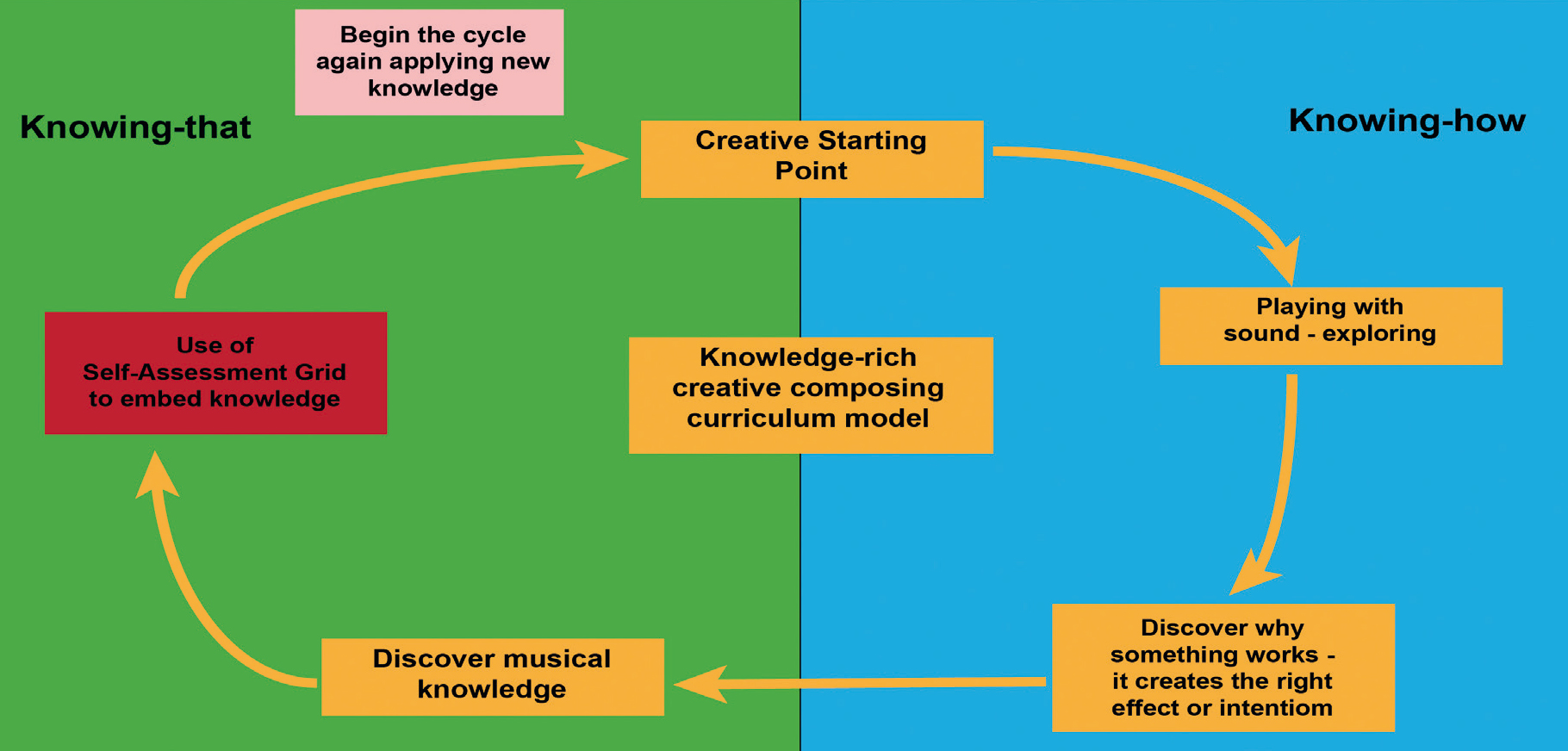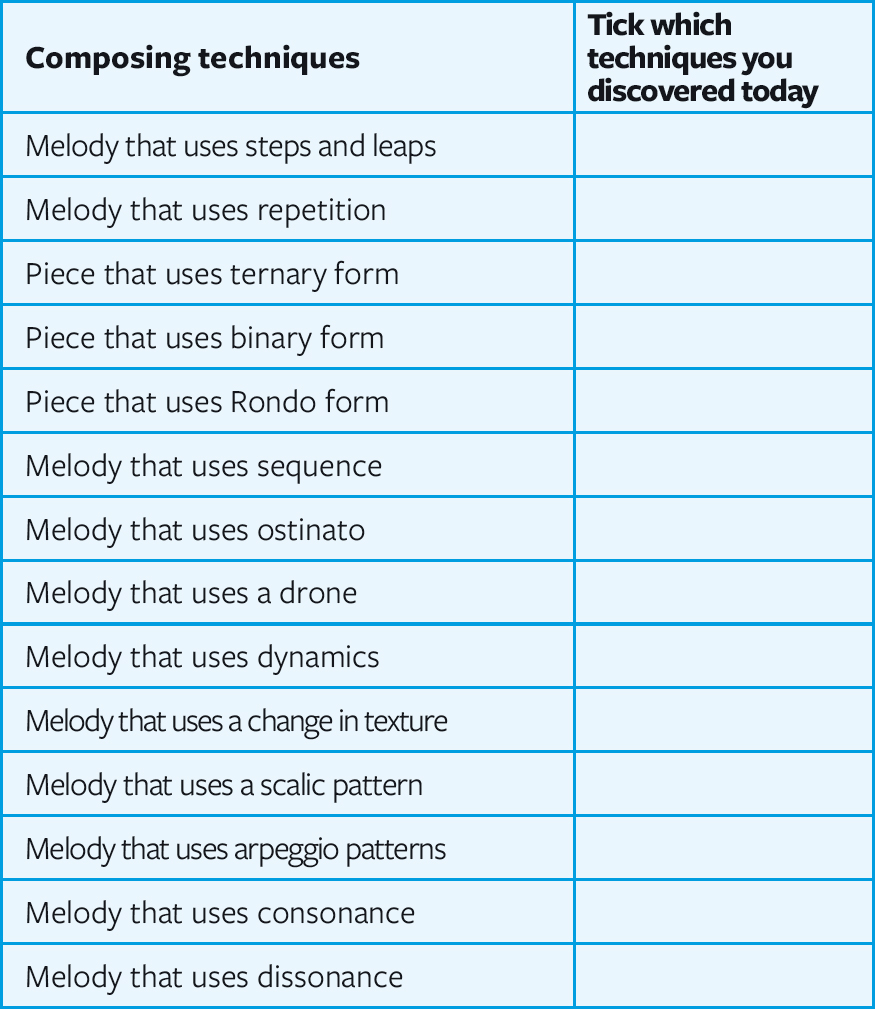
I recently completed the ‘Listen Imagine Compose’ master's degree in music education with Birmingham City University. I reflected on my own teaching and how I had been applying composing rules almost exclusively without allowing time to develop students’ creativity. My research examined whether a practical exploratory approach on the part of the students might result in more in-depth musical knowledge and understanding.
Finding a balance
Teachers have always had to try and find the right balance between teaching rules and allowing for creativity. It can be argued that knowing the rules is important because students need understanding to manipulate the musical elements. Rules can also be the source of new ideas. Students who are taught composing skills have a larger toolkit to employ in their composing. However, from my teaching experience, I found that students needed to be encouraged to think creatively and to play with sound.
Students can discover musical skills by being immersed in practical creative tasks without needing to know the technical terminology beforehand. By teaching theory after the practical creative task, we are allowing students to show us what they already know and can do by themselves, without the barrier of technical language. Leaving students to experiment allows them to work things out on their own and show that they can already make music without being taught. In this way, the students stumble upon composing concepts. These concepts can be taught by discussing the students' work and adding the theoretical knowledge afterwards.
Teachers should model the creative process so that learners can see examples of how the teacher might experiment with sounds. This gives the learners ideas, especially in the early stages before they develop their musical skills and confidence.
In primary school we may focus on the ‘play’ aspect of music-making and allow young children to play and experiment with sound. As children get older and progress through the year groups, there is often an emphasis on a more formal pedagogic approach, with later learning focussed more on skills. But all children need more opportunities that allow them to just ‘play’ with music and experiment with sound. The early secondary school years are an important time to encourage imaginative thinking and foster creativity.
Setting up tasks more creatively can submerse students in a musical experience straight away. Teachers can start teaching composing creatively with the simplest of musical ideas. Music classrooms should be places where children can make music before musical knowledge and understanding emerge, in a deeper way. Research has shown how students who are in their early musical learning journey can be given opportunities to discover musical skills through composing activities. Once students have learnt a simple melody, they can develop their skills and learning by being encouraged to create or improvise their own versions.
Creative starting points
A key part of the creative process, for the teacher, is to plan appropriate starting points that give structure to the students' learning and development. Starting points should help students come up with initial ideas and allow for freedom to experiment and develop these. We can use various types of starting points, including poems, pictures, stories and objects. As teachers, we need to consider which parameters to place alongside the starting points to ensure that the task is manageable.
Knowledge-rich curriculum
Teachers often speak of a knowledge-rich curriculum, with an emphasis on factual knowledge. We also recognise that there's an important relationship between knowledge and creativity.
I was interested to find out how composing creatively can fit into a knowledge-rich curriculum. To make novel combinations requires a knowledge-rich store in the person's mind. A knowledge-rich curriculum design includes ‘knowing-that’, which is knowing facts, and ‘knowing-how’, which is knowing how to apply the facts. My research sought to answer how the musical knowledge that students discover through playing with sound could be embedded.
 Knowledge-rich creative composing model
Knowledge-rich creative composing model
My research
I developed a new Year-7 scheme of work entitled ‘Music Creations’ with various literary, visual, and musical starting points. The first musical starting point I used was Grieg's In the Hall of the Mountain King. Students composed a piece that built excitement using the parameters of a change of tempo and crescendo.
The visual starting point I used was Joan Miró's painting The Escape Ladder. During the Second World War, Miró fled France and took his family to Palma on the island of Mallorca. While there, he created a series of paintings using shapes (on smoky backdrops) that move about and symbolise forms of dance. The Escape Ladder has swooping birds that represent the bombers flying over Spain and the desire to escape. After hearing this, students created a piece inspired by the picture, using the parameters of a change of pitch and texture.
The literary starting point I used was Christina Rossetti's poem ‘Who has seen the wind?’:
Who has seen the wind? Neither I nor you: But when the leaves hang trembling, The wind is passing through.
Who has seen the wind? Neither you nor I: But when the trees bow down their heads, The wind is passing by.
Students created a piece inspired by the poem, using the parameters of a change of dynamics and tempo.
The final musical starting point was a simple well-known melody. Students learnt the melody and then created variations on this. We discussed how melodies use steps, leaps and repetition. Students then created their own original melodies for end-of-term assessments. They enjoyed the various starting points and were quick to start creating, rarely getting stuck. They got to discover a wide range of musical concepts and often did not need the given parameters. Students love to play melodies they know and these can provide excellent starting points for creative work. The range of musical knowledge that the students discovered through their Musical Creations reinforced the importance of keeping this scheme of work in my curriculum.
Self-Assessment grid
I created a self-assessment grid (see table below), with simple statements of musical concepts that students might discover when creating their work. This was placed in student booklets and used as a reflection tool. After each group performed their composition, I put the grid on the projector and introduced the keywords for the techniques that students used. I asked all students to think about whether they had used the concept too, and to tick it on the grid if so. The grid prompted positive group discussions about musical knowledge and understanding. When students used a different technique that I had not thought of, we discussed this in class and students then added it to the blank row.
I was pleased to see that, when writing peer feedback on other student performances, students had been using key words regularly. Key concepts and terminology were being understood. Introducing key terminology through the use of the self-assessment grid in plenaries was a powerful way of reinforcing new concepts.
I designed a knowledge-rich creative composing approach. The model, illustrated on the opposite page, shows how, when given time to play with sound, students can discover musical knowledge for themselves; and how, through using the self-assessment grid, the musical knowledge is embedded.
Overall, the research has provided a rich resource to apply to other units in the curriculum, to facilitate creativity and to enrich learning, discovery and reflection.




